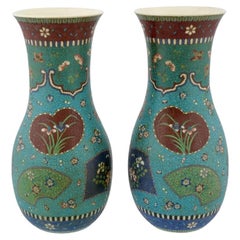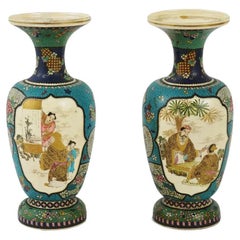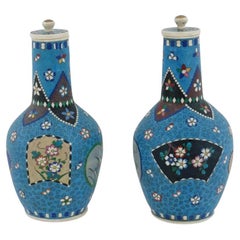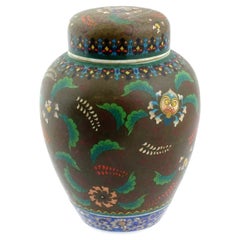Want more images or videos?
Request additional images or videos from the seller
1 of 8
Rare Kinkozan Totai Shippo Japanese Cloisonne on Porcelain Bottle
$3,000List Price
About the Item
- Dimensions:Height: 11 in (27.94 cm)Diameter: 10 in (25.4 cm)
- Style:Meiji (Of the Period)
- Materials and Techniques:
- Place of Origin:
- Period:
- Date of Manufacture:Late 19th Century
- Condition:Wear consistent with age and use.
- Seller Location:Long Island City, NY
- Reference Number:1stDibs: LU7386239658342
About the Seller
4.9
Platinum Seller
Premium sellers with a 4.7+ rating and 24-hour response times
1stDibs seller since 2022
103 sales on 1stDibs
Authenticity Guarantee
In the unlikely event there’s an issue with an item’s authenticity, contact us within 1 year for a full refund. DetailsMoney-Back Guarantee
If your item is not as described, is damaged in transit, or does not arrive, contact us within 7 days for a full refund. Details24-Hour Cancellation
You have a 24-hour grace period in which to reconsider your purchase, with no questions asked.Vetted Professional Sellers
Our world-class sellers must adhere to strict standards for service and quality, maintaining the integrity of our listings.Price-Match Guarantee
If you find that a seller listed the same item for a lower price elsewhere, we’ll match it.Trusted Global Delivery
Our best-in-class carrier network provides specialized shipping options worldwide, including custom delivery.You May Also Like
Japanese Totai Shippo Porcelain Covered Box
Located in Philadelphia, PA
A fine Japanese porcelain box.
Decorated to the exterior with a dark turquoise enamel ground with floral decorations. The figural finial as wel...
Category
20th Century Japanese Meiji Ceramics
Materials
Enamel
Antique Japanese Totai Shippo Cloisonné on Satsuma Plate Japanese, 19th Century
Located in Amsterdam, Noord Holland
A Japanese Totai Shippo cloisonne (cloisonné ) pottery plate. The plate has the usual cream coloured body that is normally associated with satsum...
Category
Antique 19th Century Chinese Decorative Dishes and Vide-Poche
Materials
Porcelain
$398 Sale Price
20% Off
H 1.07 in Dm 8.51 in
Large Japanese Satsuma Ceramic Vase Kinkozan
By Kinkozan
Located in Atlanta, GA
A large Japanese ceramic vase from the end of Meiji period circa 1890-1910s by Kinkozan (1645-1927). One of the largest studio manufacturers of the export ceramics at the time based in Kyoto. In the typical style of satsuma made at the turn of 20th century, the vase is elaborately decorated with a rather unusual kinran-de (gold paint) and green enamel highlight on a mottled brown background. The painterly decoration depicts a large seasonal floral arrangement in a circular fashion. Besides the obviously superb craftsmanship, what sets this particular vase apart from many lower quality and mass-produced pieces is its tone-on-tone color pallet that is visually somber and the small and sensitive details that heralds the change of the seasons. When the viewer goes beyond the first casual glimpse of the blossom and foliage, one would notice that on the edges of certain leaves as well as along the stalks, there accumulates a very thin layer of the white dust that represents the frost. The flower in bloom are chrysanthemums. Despite of being splendid, they are the messengers of the autumn. The large lotus leaf was subtly rendered in a bended and slightly withered manner, just past its prime. Although the lotus is still in bloom, the prominent seed pod indicates it may be the last for the season. The sentimental capture of the change of the seasons is not unusual in Japanese art. This vase poetically represents such a subtle transition from summer to fall, perhaps depicting the very first frost.
The neck of the vase is also slightly unusual with two rolled rings...
Category
Early 20th Century Japanese Meiji Ceramics
Materials
Ceramic
Fine Japanese Ceramic Satsuma Vase by Kinkozan
By Kinkozan
Located in Atlanta, GA
A miniature Japanese ceramic vase from the end of Meiji period circa 1880s- 1910s by Kinkozan (1645-1927). One of the largest studio manufacturers of the export ceramics at the time ...
Category
Early 20th Century Japanese Meiji Ceramics
Materials
Ceramic
Japanese Pair Meiji Cloisonne Bottle Vases with Scattered Floral Designs
Located in Bishop's Stortford, Hertfordshire
A fine pair Japanese Meiji period cloisonne bottle shaped vases decorated with scattered floral patterns and dating between 1868 and 1912. The vases are lightly made standing on a fl...
Category
Antique 19th Century Japanese Meiji Metalwork
Materials
Brass
$606 / set
Free Shipping
H 7.88 in Dm 4.34 in
4 Japanese NASCO Porcelain Sake Bottles
Located in Norton, MA
4 Japanese NASCO Porcelain Sake Bottles, Mid-20th century.
Green drip-glazed porcelain with cork-lined stopper. Some of the cork has deteriorated. Label on...
Category
Mid-20th Century Japanese Bottles
Materials
Stoneware
Fine Japanese Enameled Satsuma Vase by Kinkozan Meiji Period
By Kinkozan
Located in Atlanta, GA
A ceramic satsuma ware vase with very fine surface decoration made by Kinkozan circa 1880-1900s of late Meiji Period. The vase is of an elegant and relatively rare form with a trumpet shape body and the so-called garlic neck and opening. The surface is exquisitely decorated in a floral scheme with gilt and a light jewel-tone enamel. The top part showcases large bundles of wisteria blossom in white and purple, cascading down from a gilt wood trellis...
Category
Antique 1880s Japanese Meiji Ceramics
Materials
Ceramic
Rare Japanese Cloisonné Enamel Vase with Kingfisher and Reeds, Hayashi Kodenji
Located in Queens, NY
A Rare Japanese Meiji Period Lobed Silver-Wire Cloisonné Enamel Vase with Kingfisher and Reeds, Attributed to the Hayashi Kodenji Studio
A rare and elegant Japanese cloisonné enamel...
Category
Antique 19th Century Japanese Meiji Vases
Materials
Copper, Enamel
$12,000
H 10 in Dm 5 in
Fine Japanese Satsuma Ceramic Jar with Gilt Decoration by Kinkozan
By Kinkozan
Located in Atlanta, GA
A large Japanese ceramic vase from end of Meiji period circa 1880s- 1910s by Kinkozan (1645-1927). One of the largest studio manufacturers of the export ceramics at the time based in Kyoto. In the typical style of satsuma made at the turn of 20th century, the vase is of a moon jar shape and finely decorated with kinran-de (gold paint) on a cream white background with even fine crackles. What sets this particular vase apart from many lower quality and mass-produced pieces is the meticulously renditioned surface decoration. Lavishly gilded with a continuous design, the carefully composed imagery depicts an elaborately decorated float cart in a festival parade. A group of people are seated within the float with a woman and a child standing in the front. Surrounding the float are streams of marchers dressed...
Category
Early 20th Century Japanese Meiji Ceramics
Materials
Ceramic
Antique Japanese Meiji Period (1868-1912) Satsuma Vase by Kinkozan
By Kinkozan
Located in Newark, England
Signed Kinkozan 金光山
From our Japanese collection, we are delighted to offer this Japanese Satsuma Vase by Kinkozan. The vase is potted in globular form with a tightly pinched neck and rolled top rim beautifully decorated with four highly detailed individual panelled scenes. The first a Geisha baring a gilt basket with her child playing with a fan infant of a gilt fence encompassing blossoming foliage and bamboo plants. The second scene depicts two birds, a Red Headed Japanese Wood Pigeon and a white dove in the foreground with a similar gilt fence with blossoming kiku flowers (chrysanthemums). The third scene is painted as a bustling village community with multiple figures going about their daily jobs, a central Palanquins can be seen with two figures carrying a seating figure. To the background a mountainous river landscape can viewed bordering the top left corner. The final scene appears similar to the opposing one with birds swooping high above a polychrome Japanese...
Category
Antique Late 19th Century Japanese Meiji Vases
Materials
Ceramic, Earthenware, Pottery
$10,332
Free Shipping
H 7.88 in Dm 5.91 in
More From This Seller
View AllRare Totai Shippo Pair Large Japanese Cloisonne On Porcelain Enamel Vases
Located in Long Island City, NY
A pair of rare symmetrical large antique Japanese, Ming era, Totai porcelain vases. Each vase has a globular shaped body and a fluted mouth. The exteriors of the wares are covered wi...
Category
20th Century Japanese Ming Vases
Materials
Porcelain
$7,500 Sale Price / set
50% Off
Kinkozan Japanese Cloisonne Enamel Totai Scholars Satsuma Signed Vases
Located in Long Island City, NY
A large pair of antique Japanese Totai Shippo cloisonne enamel and Satsuma porcelain vases, Meiji era, 1868 to 1912. Of a baluster form, on the b...
Category
Antique Late 19th Century Japanese Meiji Vases
Materials
Enamel
Japanese Totai Cloisonne Enamel On Porcelain Bottles
Located in Long Island City, NY
A pair of Japanese covered Totai enamel on porcelain bottles. The wares are enameled with polychrome figural medallions representing blossoming flowers surrounded by floral, foliage ...
Category
Antique 19th Century Japanese Meiji Metalwork
Materials
Enamel
$1,500 Sale Price / set
50% Off
Large Japanese Totai Covered Cloisonne Enamel Porcelain Jar
Located in Long Island City, NY
A large Japanese covered Totai enamel on porcelain ginger jar. The ware is enamelled with polychrome floral and foliage ornaments made in the Cloisonne technique. The cover of the wa...
Category
Antique Late 19th Century Japanese Jars
Materials
Enamel
Meiji Japanese Totai Cloisonne Enamel Ceramic Jar
Located in Long Island City, NY
An antique Japanese late Meiji era covered Totai enamel on ceramic ginger jar. Circa: late 19th century to early 20th century. The ware is enameled with a polychrome fan shaped medallions with blossoming flowers, bamboo trees, grapes, surrounded by a geometrical pattern made in the Cloisonne technique. The cover of the ware is decorated with polychrome fan shaped medallions with blossoming flowers. The neck and the lid are adorned with polychrome geometrical, and swirl motifs made in the same technique. Signed with red ink hieroglyphs, on the bottom. Totai Shippo...
Category
Antique Late 19th Century Japanese Meiji Jars
Materials
Enamel
Large Antique Meiji Japanese Cloisonne Enamel Porcelain Totai Vase
Located in Long Island City, NY
An antique Japanese Meiji period cloisonne enamel porcelain vase, characterized by its exquisite multi colored floral and foliage motifs on a green ground. The use of a vibrant color...
Category
Antique Late 19th Century Japanese Vases
Materials
Porcelain
Recently Viewed
View AllMore Ways To Browse
Rare Japanese Porcelain
Sake Bottle
Japanese Cloisonne Porcelain
Japanese Shippo Vase
Japanese Totai Shippo
Ceramic Glossy Vase
Ceramic Shell Vases
Chinese Champleve
Chinese Cherry Blossom Porcelain Vase
Chinese Ching
Cobalt Crystal Vases
English Antique Large Vases
English Regency Vase
Engraved Brass Vase
Filigrana Glass Vase
Flavia Italy
Folded Vase
French Chinoiserie Blue



